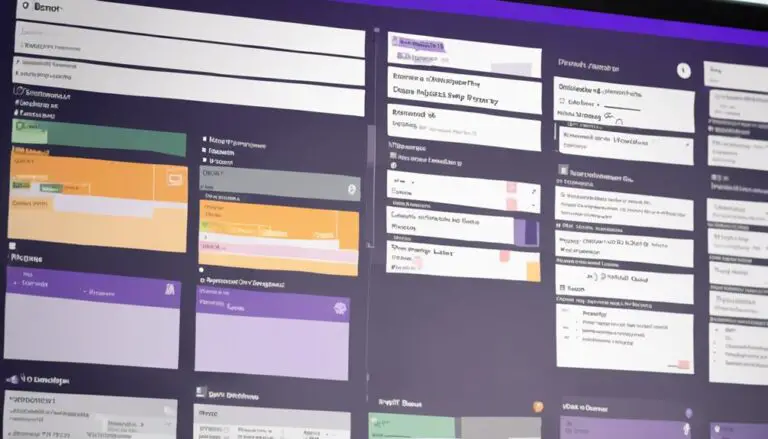When navigating the intricate landscape of Kanban methodology, the question arises: does Kanban truly require a Product Owner at its helm? The role of a Product Owner in Kanban is not explicitly defined, as Kanban is more focused on continuous improvement rather than traditional roles and responsibilities. However, having a dedicated individual who understands the needs of the customer and can prioritize work accordingly can greatly benefit the team. This is where the Kanban product owner role comes into play, as they can help facilitate communication between stakeholders and the team, and ensure that the right work is being done at the right time.
As you ponder the dynamics of this pivotal role, consider the nuanced interplay between ownership, value delivery, and team collaboration within the Kanban framework.
How does the presence or absence of a Product Owner influence the flow of work, decision-making processes, and overall project outcomes in Kanban projects?
Explore the critical insights and practical implications that this comprehensive guide unveils, shedding light on the essence of a Product Owner's role in the Kanban ecosystem.
Key Takeaways
- Product Owner ensures customer needs drive Kanban
- Role clarity enhances team alignment
- Decision-making efficiency crucial for value delivery
- Without Product Owner, challenges in prioritization and communication
The Role of Product Owner in Kanban
In Kanban, the Product Owner actively represents customer needs and ensures their integration into the product development process. As the Product Owner, your primary focus is on delivering customer value. By prioritizing and managing the product backlog, you collaborate with stakeholders to define requirements that align with the customers' expectations. Your role goes beyond just managing tasks; you serve as the voice of the customer within the team, ensuring that their needs are met in each iteration.
Facilitating communication among team members is crucial in Kanban. As the Product Owner, you play a vital role in fostering collaboration and keeping everyone aligned with the customer's goals. Adapting to changes in customer needs is a key responsibility, as the market landscape is ever-evolving. Your ability to pivot and adjust the product direction based on customer feedback is instrumental in delivering value with each iteration.
Benefits of Having a Product Owner
Transitioning smoothly from understanding the role of a Product Owner in Kanban, let's now explore the tangible benefits that having a Product Owner brings to the table.
The Product Owner plays a pivotal role in ensuring the clear prioritization and effective management of the product backlog. By collaborating with stakeholders, the Product Owner helps define requirements and expectations for the product, aligning the team towards a common goal. This results in the team consistently delivering value with each iteration, enhancing overall productivity and customer satisfaction.
Moreover, the Product Owner facilitates communication among team members, maintaining alignment and focus throughout the development process. This fosters a collaborative environment where ideas flow freely, leading to innovative solutions. Additionally, the Product Owner's adaptability to changes in customer needs and market trends is crucial for the success of the product in Kanban. Their ability to pivot quickly and make informed decisions based on real-time feedback ensures that the product remains competitive and relevant in the ever-evolving market landscape.
Challenges Without a Product Owner
Without a Product Owner in Kanban, you might find it challenging to establish clear roles and responsibilities, potentially leading to confusion within the team.
Decision-making efficiency could suffer due to a lack of a central authority for prioritization and direction, hindering progress.
Ensuring that customer needs are met might become more complicated without a dedicated advocate to champion their requirements and expectations.
Role Clarity Importance
With a clear understanding of role clarity in Kanban, teams can effectively navigate challenges that arise from the absence of a Product Owner. Here are five important points to consider:
- Lack of a dedicated customer advocate
- Difficulty in prioritizing work based on customer needs
- Confusion in understanding customer requirements
- Challenges aligning team efforts towards customer satisfaction
- Potential delays in decision-making
Establishing role clarity through a Product Owner in Kanban is vital for streamlining processes, prioritizing effectively, and ultimately enhancing customer satisfaction. By recognizing the significance of role clarity, teams can overcome obstacles and work cohesively towards delivering value to customers.
Decision-Making Efficiency Benefits
To optimize decision-making efficiency in Kanban, having a Product Owner plays a crucial role in prioritizing and organizing the product backlog effectively. Without a Product Owner, challenges may arise in determining the order of work items and prioritizing user stories efficiently. A Product Owner ensures that customer needs are integrated into the product, ultimately enhancing overall process efficiency.
The absence of a Product Owner can result in delays in delivering value to customers and meeting their expectations promptly. By having a Product Owner in Kanban, communication, feedback integration, and decision-making processes within the team are streamlined, leading to smoother operations and a more responsive approach to customer needs.
Adapting Product Owner Responsibilities
You might want to consider how your role as a Product Owner can be adjusted to better meet the evolving needs of your customers and stakeholders.
Collaborating closely with your team members and employing effective prioritization techniques are essential aspects to focus on.
Role Adjustment Considerations
Considering the Kanban methodology's emphasis on flexibility and adaptability, reevaluating the traditional Product Owner responsibilities becomes essential to ensure alignment with the framework's principles and goals.
- Embrace Collaborative Decision-Making: Foster a team environment where decisions are made collectively.
- Customer Advocacy Integration: Evaluate the need for a customer advocate role to ensure customer needs are met.
- Stakeholder Representation: Assess the importance of representing stakeholders to deliver value effectively.
- Focus on Process Efficiencies: Tailor the Product Owner role to enhance process efficiencies.
- Adapt to Evolving Roles: Understand the evolving nature of roles in Kanban and adjust Product Owner responsibilities accordingly.
Collaboration With Team
In Kanban, collaborating with the team to adapt Product Owner responsibilities is key to aligning with organizational needs and fostering flexibility. This collaboration involves a continuous improvement mindset, where the Product Owner works alongside the team to refine and define roles.
By customizing responsibilities to fit the specific project requirements and existing team practices, a harmonious workflow is achieved. Emphasizing alignment with customer needs, the Product Owner plays a crucial role in ensuring that the team delivers value effectively.
Through this collaborative approach, the team can adapt and evolve, responding swiftly to changes and optimizing processes for better outcomes. Together, embracing continuous improvement and teamwork enables a seamless integration of Product Owner responsibilities within the Kanban framework.
Prioritization Techniques
To effectively adapt Product Owner responsibilities in Kanban's prioritization techniques, it's crucial to align with evolving project demands and customer expectations through continuous collaboration with the team.
- Embrace Feedback: Actively seek and incorporate feedback to adjust priorities accordingly.
- Stay Agile: Be flexible and responsive to changing priorities and market demands.
- Customer-Centric Approach: Prioritize tasks that add the most value to customers.
- Transparency is Key: Ensure transparency in prioritization decisions to foster trust and alignment within the team.
- Continuous Improvement: Regularly review and refine prioritization strategies to optimize team performance and product delivery.
Distributing Responsibilities in a Kanban Team
When organizing responsibilities within a Kanban team, leverage individual expertise and customer insights to optimize workflow efficiency.
In Kanban, responsibilities can be distributed among team members based on their specific skills and understanding of customer needs.
Utilizing the concept of classes of service, requests can be classified according to urgency levels, enabling a tailored approach to managing work items.
These classes of service not only help in organizing work but also allow for customization beyond standard categories, enhancing flexibility within the team.
Each class of service in Kanban is associated with its unique level of urgency and delivery delay, contributing to a more streamlined workflow.
Integrating a Product Owner in Kanban
Leverage the expertise and customer insights within your Kanban team by integrating a Product Owner to enhance customer focus and ensure effective meeting of their needs.
- Enhanced Customer Focus: The Product Owner ensures that customer needs are at the forefront of decision-making.
- Stakeholder Representation: The Product Owner acts as a voice for stakeholders and aligns team efforts with their interests.
- Prioritization: Helps in prioritizing work items based on customer value and business needs.
- Communication Facilitation: Facilitates clear communication between the team and customers, ensuring alignment.
- Value Delivery: Ensures that the team delivers value to customers consistently and adapts to market changes efficiently.
Determining the Need for a Product Owner
Considering the dynamics of your Kanban team and the unique needs of your project, evaluating the necessity of a Product Owner role can significantly impact your workflow and outcomes.
In Kanban, the focus is on the flow of work on the Kanban board, with an emphasis on existing roles and practices rather than mandating a Product Owner. Customization options in Kanban allow for defining classes of service tailored to your specific project requirements beyond standard archetypes. These classes of service help classify work requests based on urgency levels, facilitating better prioritization on the Kanban board.
Setting Service Level Expectations (SLE) for each class enables negotiations of Service Level Agreements (SLA) with clients, ensuring alignment with stakeholder expectations. Transitioning from Scrum to Kanban may involve retaining the Product Owner role to maintain effective communication with stakeholders throughout the workflow.
Frequently Asked Questions
What Is Equivalent to Product Owner in Kanban?
In Kanban, the role equivalent to a Product Owner is the Service Request Manager (SRM). They focus on customer needs, prioritize requests, and manage workflow efficiency. Unlike Scrum, SRM's role is more service-oriented.
Who Is Responsible for Kanban?
Juggle responsibilities in Kanban by involving key players. Embrace adaptability as you navigate tasks and enhance efficiencies. Collaborate with empathy to maintain a smooth flow, ensuring value delivery and stakeholder satisfaction.
What Are the Mandatory Roles in Kanban?
In Kanban, role clarity is key for effective teamwork. Decision making is shared, allowing for adaptability. While no mandatory roles exist, defining responsibilities based on team needs ensures success. Customization fosters collaboration in Kanban.
Who Is the Owner on a Kanban Board?
You are the owner on a Kanban board, embodying customer needs and representing stakeholders. In Kanban, roles like Product Owner, Scrum Master, Team Lead, and Project Manager blend to ensure customer value, fostering collaboration and adaptability.
Conclusion
As you navigate the Kanban landscape, remember: a Product Owner is the beacon guiding your team through choppy waters. Without one, you risk drifting aimlessly, lost in a sea of tasks.
Embrace the power of collaboration, adaptability, and clear communication. Let the Product Owner steer your ship towards success, ensuring value delivery and effective teamwork.
Together, you can conquer any challenge that comes your way. Bon voyage!





